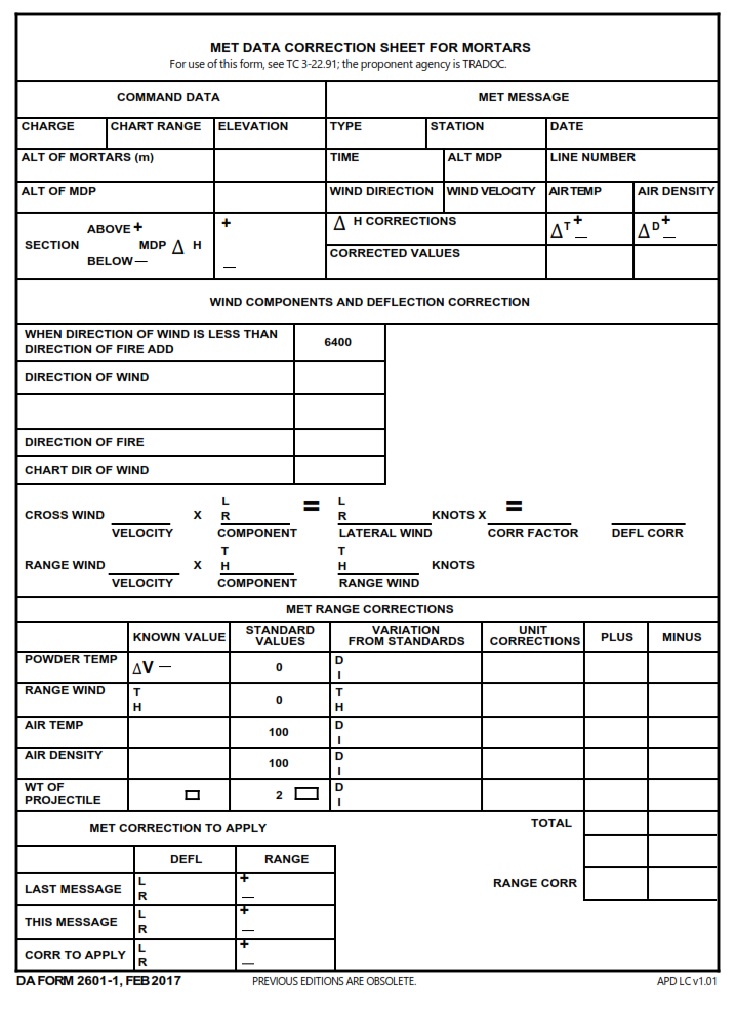Table of Contents
FREE-ONLINE-FORMS.COM – DA Form 2601-1 – Met Data Correction Sheet For Mortars – Ever wondered what goes into ensuring the accuracy of mortars on the battlefield? Look no further than DA Form 2601-1 – Met Data Correction Sheet For Mortars. This seemingly mundane document holds the key to correcting meteorological data for mortar firing operations, and its importance cannot be understated. From adjusting for wind speed and direction to factoring in temperature and humidity, this form plays a crucial role in ensuring that every mortar fired hits its intended target with deadly precision. In this article, we’ll dive deep into the world of met data correction sheets for mortars, uncovering their significance in modern warfare.
They say war is an art, but behind every masterpiece lies meticulous planning and precise execution. And when it comes to launching mortars on enemy lines, accuracy is everything. Enter DA Form 2601-1 – Met Data Correction Sheet For Mortars: a little-known yet indispensable tool that separates success from failure on the battlefield. With factors like atmospheric conditions and terrain influencing each shot fired, this form serves as a lifeline for artillery units striving to hit their targets dead on. Join us as we unravel the secrets behind this unsung hero of military precision – because sometimes victory depends on just a few degrees of adjustment.
Download DA Form 2601-1 – Met Data Correction Sheet For Mortars
| Form Number | DA Form 2601-1 |
| Form Title | Met Data Correction Sheet For Mortars |
| Edition Date | 2/1/2017 |
| File Size | 28 KB |
What is a DA Form 2601-1?
The DA Form 2601-1 may not be a familiar term to most people, but for those involved in the field of mortars and artillery, it holds significant importance. This form, officially known as the Met Data Correction Sheet for Mortars, is used to track and correct crucial meteorological data that directly impacts the accuracy and efficacy of mortar operations.
In the realm of military operations, weather conditions play a critical role in determining the success or failure of missions. The DA Form 2601-1 serves as a tool for mortar crews to record and analyze meteorological information such as temperature, humidity, wind speed, and direction. By accurately monitoring these factors at different firing positions and recording them on this form, operators can precisely calculate trajectories and make necessary adjustments to ensure better-targeting outcomes.
Not only does this form assist with real-time operational decision-making, but it also creates a valuable resource for future reference. Constantly updated with reliable meteorological data collected from various locations over time, the DA Form 2601-1 becomes a powerful tool that helps forecast trends in environmental conditions. This information proves invaluable when planning future missions or analyzing past engagements. So while it might seem like just bureaucratic paperwork to some, the DA Form 2601-1 plays an integral role in enhancing mortar precision and ultimately contributes to mission success on the battlefield.
Where Can I Find a DA Form 2601-1?
If you’re in the military or have ever dealt with military paperwork, you know how important it is to have the right forms. One such form that may be needed when dealing with mortars is DA Form 2601-1 – Met Data Correction Sheet For Mortars. This form is used to track and correct any errors or discrepancies in meteorological data related to mortar operations. So, where can you find this essential form?
One of the first places to check is your unit’s supply office. They should have a stock of all the necessary forms for various operations, including DA Form 2601-1. If they don’t have it on hand, they may be able to order it for you or point you in the right direction.
Another option is to search online on official military websites. The Army Publishing Directorate (APD) website, for example, provides access to a range of official Army forms and publications. Simply visit their website and navigate to the Forms section, where you can search by keyword or form number.
It’s also worth checking with other soldiers who may have recently encountered this form. They might be able to provide guidance on where they obtained it from or any alternative methods they used.
Ultimately, if all else fails and you’re unable to locate a physical copy of DA Form 2601-1 through conventional means, consider contacting higher command personnel or consulting with your unit’s resources officer (S4/G4) for further assistance.
In conclusion, while tracking down
DA Form 2601-1 – Met Data Correction Sheet For Mortars
DA Form 2601-1, also known as the Met Data Correction Sheet for Mortars, may seem like just another mundane form in the military arsenal. However, its significance cannot be overlooked when it comes to accurately assessing weather conditions and making necessary adjustments in mortar operations. These correction sheets play a crucial role in ensuring precise targeting and maximizing effectiveness on the battlefield.
By meticulously recording meteorological data such as temperature, wind speed, humidity, barometric pressure, and precipitation, this form becomes an invaluable tool for pinpointing potential errors or discrepancies that could impact mortar firing accuracy. The insights gleaned from analyzing this information can lead to adjustments in elevation calculations and fuse settings – two critical aspects that directly influence how effectively mortars hit their targets.
This met data correction sheet goes beyond being a mere bureaucratic requirement; it is a powerful instrument that empowers mortar crews with real-time insights into weather conditions. Armed with this knowledge, they can make timely adjustments to ensure optimal results on the battlefield.
